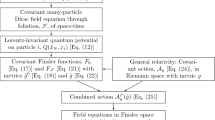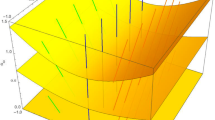Abstract
We shall show that the self-interaction of a field can be geometrized together with its perturbations in the sense that both dynamics are controlled by the same metric.
Access provided by Autonomous University of Puebla. Download conference paper PDF
Similar content being viewed by others
Keywords
- Emergent Metric
- Emergent Spacetime
- Geometrical Optics Limit
- Dynamical Scalar Field
- Control Systems Laboratory
These keywords were added by machine and not by the authors. This process is experimental and the keywords may be updated as the learning algorithm improves.
1 Introduction
The main idea in the analogue models program is to simulate gravitational configurations in condense matter physics or using electromagnetic fields in non-linear medium (see [1, 2]). Hence, to study some of the features of general relativity theory by using controlled laboratory systems. The connection can be made once we notice that the evolution of the perturbations of a given field can be described in a geometrical language. Even though the majority of works in the literature concern only the perturbative regime, it has been shown in Ref. [3] that one can also geometrize the dynamics of the background field simultaneously with its perturbations.
The geometrization of the perturbation dynamics alone has only a kinematical value. It is a change of description valid only for the perturbations. Thus, the effective metric that defines the evolution of the perturbations cannot be interpreted as a real geometry as it is done in general relativity.
For a scalar nonlinear theory with \(L(\varphi , w)\), where \(w \equiv \gamma ^{\mu \nu } \partial _{\mu } \varphi \, \partial _{\nu } \varphi \) is the kinetic term, the equation of motion is a quasi-linear second order partial differential equation for \(\varphi \). Its principal part that defines the effective metric
determines the causal structure of the theory (see [4] for details). Furthermore, by constructing a Riemannian affine structure such that \(\hat{g}_{\alpha \beta ||\nu }=0\), the rays describing the perturbations of the scalar field follow null geodesics in the effective metric \(\hat{g}_{\mu \nu }\). Therefore, the effective metric determines the causal structure and controls the propagation of the field’s excitations in the geometrical optics limit.
1.1 Geometrization of Field Dynamics
The general approach in analogue models deals simultaneously with two metrics, one for the perturbations and another for the background. The geometrization scheme is valid only for the perturbations while the background field works only as a medium which defines the effective metric. This is probably the main difficulty in trying to consider the effective metric as an emergent metric with the status of a Riemannian metric as in general relativity.
A considerable improvement in this program is to include the background field in the geometric description. Thus, we want to define an emergent metric that simultaneously encodes the dynamics of the background field and its perturbations.
It has been shown in Ref. [3] that any scalar non-linear theory described by the Lagrangian \(L(w,\varphi )\) is equivalent to the field \(\varphi \) propagating in an emergent spacetime with metric \(\hat{h}_{\mu \nu }(\varphi ,\partial \varphi )\) and a suitable source \(j(\varphi , \partial \varphi )\). The emergent metric \(\hat{h}_{\mu \nu }\) and the source field \(j\) are both constructed explicitly in terms of the field and its derivatives. In addition, in the optical limit, the wave vectors associated with perturbations follow null geodesics in the same \(\hat{h}_{\mu \nu }\) metric. Therefore, there is an emergent spacetime “generated” by the non-linearity of the scalar field dynamics which dictates the propagation of the scalar field.
The equation of motion for the scalar field can be written as
We shall define the emergent metric and its inverse as
To show that the above equation can be written as a Klein-Gordon in the \(\hat{h}_{\mu \nu }\) metric, we need to calculate its determinant which amounts to \( \sqrt{-\hat{h}}=\frac{L_w^2}{\left( 1+\beta w\right) ^{3/2}}\sqrt{ -\gamma }\). Therefore, a straightforward calculation shows that
Comparing the above equation with (1), we see that
The last but very important point is to show that the effective metric associated with the perturbations is the same as defined above. This is straightforward once we realize that \(\hat{h}_{\mu \nu }\) and \(\hat{g}_{\mu \nu }\) are conformally related, i.e. \(\hat{h}^{\mu \nu }=\frac{\sqrt{1+\beta w}}{L_w^2}\hat{g}^{\mu \nu } \). Thus, the rays also propagate as null geodesics in \(\hat{h}^{\mu \nu }\).
The emergent metric \(\hat{h}_{\mu \nu }\) encodes simultaneously the dynamics of the nonlinear field and its perturbations. This result goes further in the analogue program inasmuch it includes the dynamics of the background field. Note, however, that it is imperative that the non-linearity should be in the kinetic term. Algebraic non-linearities such as \( L(w,\varphi )=w+V(\varphi )\) with \(V(\varphi )\) any function of the scalar field, trivialize the effective metric in the form of the Minkowski metric. Thus, it is the non-linearity in \(w\) that is essential to generate the curved emergent spacetime. Additionally, in the other sense, in the particular case of a theory where the Lagrangian does not depend explicitly on \(\varphi \), i.e. \(L(w)\), equation (3) reduces to a “free" wave propagating in a curved spacetime generated by itself
We have used the term “free” field above but one should keep in mind that the emergent metric depends non-trivially on the scalar field \(\varphi \). Thus, the above “free” Klein-Gordon equation is actually a complicated non-linear equation for \(\varphi \). Notwithstanding, as we have discussed in Sect. 1, there is a similar situation in general relativity when we use the term free scalar field. There, the metric appearing in the Klein-Gordon equation brings information from Einstein’s equation that also depends on \(\varphi \), hence making the coupled system a very non-linear and involved system of equations (see [3] for details).
2 General Remarks
The early proposal of general theory of relativity to encode gravitational interactions within the metrical structure of the spacetime is strongly supported by the universality of the interaction and the equality between inertial and gravitational masses. In this manner, once this identification is done, the evolution of a particle in flat spacetime subjugated to gravitational forces is equivalent to a Riemannian curved spacetime free of any force. In this scenario there is a unique metric that works as a background structure where the dynamics of all fields are defined.
We have argued that the non-linearities in the kinetic term of the scalar field also allow us to define a curved spacetime which incorporates its dynamics. The main difference from general relativity is that the metric thus defined depends explicitly on the scalar field while in GR the spacetime metric depends only implicitly through Einstein’s equations. In addition, we do not have any guarantee that this metric is universal in the sense that all fields would incorporate it in their dynamics. On the contrary, this result seems to show that the geometrization of each non-linear theory would define different metrics. Nevertheless, the possibility of defining a single metric for interacting non-linear fields is not excluded. If we consider two interacting non-linear fields it might be possible to define a single Riemannian metric that encodes both non-linearities. Notwithstanding, the inclusion of interaction is a non-trivial step that deserves careful analysis in the future.
References
Gordon, W.: Zur Lichtfortpflanzung nach der Relativitätstheorie. Ann. Phys. (Leipzig) 72, 421 (1923). doi:10.1002/andp.19233772202
Novello, M., Visser, M., Volovik, G. (eds.): Artificial Black Holes. World Scientific, Singapore (2002)
Goulart, E., Novello, M., Falciano, F., Toniato, J.: Hidden geometries in nonlinear theories: a novel aspect of analogue gravity. Class. Quantum Gravity 28, 245008 (2011). doi:10.1088/0264-9381/28/24/245008
Jeffrey, A., Taniuti, T.: Non-linear wave propagation, with applications to physics and magnetohydrodynamics, mathematics in science and engineering, vol. 9. Academic Press, London (1964)
Acknowledgments
We would like to thank E. Goulart, M. Novello and J. D. Toniato for helpful comments and useful discussions.
Author information
Authors and Affiliations
Corresponding author
Editor information
Editors and Affiliations
Rights and permissions
Copyright information
© 2014 Springer International Publishing Switzerland
About this paper
Cite this paper
Falciano, F.T. (2014). Probing the Spacetime Structure Through Dynamics. In: Bičák, J., Ledvinka, T. (eds) Relativity and Gravitation. Springer Proceedings in Physics, vol 157. Springer, Cham. https://doi.org/10.1007/978-3-319-06761-2_35
Download citation
DOI: https://doi.org/10.1007/978-3-319-06761-2_35
Published:
Publisher Name: Springer, Cham
Print ISBN: 978-3-319-06760-5
Online ISBN: 978-3-319-06761-2
eBook Packages: Physics and AstronomyPhysics and Astronomy (R0)




